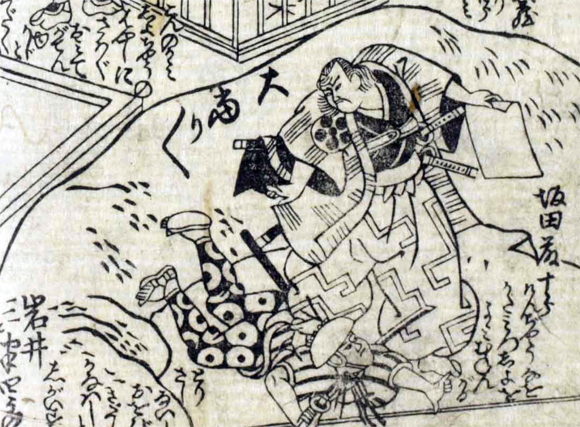| YOSHIDA SHATÔ |
| Play title | Ôshû Adachi-ga-Hara |
| Common title | Yoshida Shatô In Front of the Yoshida Shrine |
| Authors | Chikamatsu Hanji Takeda Izumi Kitamado Goichi Takemoto Saburobê II |
| History |
Chikamatsu Hanji's play in five acts "Ôshû Adachi-ga-Hara" was originally written for the puppets theater in 1762. It was adapted for Kabuki in the 2nd lunar month of 1763 and staged at the Moritaza [casting|illustrations]. The historical background of this play is the zenkunen war, which opposed the Abe clan, ruler of the northern provinces of Japan (Ôshû), to the Minamoto clan. The latter clan, led by Minamoto no Yoriyoshi and his son Minamoto no Yoshiie, defeated the former clan, led by Abe no Yoritoki and his two sons, Abe no Sadatô and Abe no Munetô. After the war, the two sons became fugitives and the play is about their actions and their last murder attempts against their victor. The playwrights also integrated within this drama two famous Ôshû legends, the ogress of Adachi-ga-Hara and the utô bird. "Yoshida Shatô", 'in front of the Yoshida Shrine', was staged only once since the end of WWII, in April 1978 at the National Theatre, with Onoe Kikugorô VII, Sawamura Tôjûrô II, Nakamura Kankurô V, Ichikawa Nedanji II and Bandô Kôtarô in the roles of Shigasaki Ikomanosuke, Koiginu, Kushige-no-Naishi and Taira Kenjô Naokata. |
| Structure |
"Yoshida Shatô", 'in front of the Yoshida Shrine', is the middle scene (2nd scene) of the first act of "Ôshû Adachi-ga-Hara". |
| Key words |
Abe Munetô Abe Sadatô Abe-shi Abe Yoritoki Adachi-ga-Hara Gidayû Kyôgen Jidaimono Keisei Koshimoto Minamoto Yoriyoshi Minamoto Yoshiie Naishi Ôshû Torisashi Yoshida Jinja Zenkunen |
| Summary |
Prince Tamaki-no-Miya, younger brother of the Emperor, visits the Yoshida Shrine in Kyôto, accompanied by the naishi Kushige and several koshimoto. Shigasaki Ikomanosuke, a retainer of Hachiman Tarô, arrives and reports to the prince that he has come to act as an escort to him by order of his master. The keisei Koiginu, with whom Ikomanosuke is in love, appears and flirts with him when Uriwari Shirô, another retainer of Hachiman Tarô, arrives and falsely tells Ikomanosuke that his master is calling him. When Ikomanosuke goes away, he makes amorous advances to Koiginu but he is interrupted by the arrival of Hanbê, a professional bird catcher (torisashi). The bird catcher, who is secretly in the employ of the Abe clan, puts a letter into the sleeve of Kushige's kimono while pretending to perform a dance. Kushige throws it back. The other ladies-in-waiting accuse the bird catcher of his rude act. He tries to attack them but quickly runs away. Taking advantage of the confusion, Kushige takes the prince away with her. Taira Kenjô Naokata, who is responsible for the protection of Prince Tamaki-no-Miya, arrives to look for the prince and asks the bird catcher what has happened to him. The bird catcher kills himself by stabbing his throat with a dagger. Naokata searches his body and finds a letter asking Kushige to take Prince Tamaki-no-Miya away. The letter has no signature, but Naokata suspects that it was written by Ôe Koretoki. |
 |
|
Illustration for the "Yoshida Shatô" scene from the ezukushi banzuke of the drama "Ôshû Adachi-ga-Hara", which was staged in the 5th lunar month of 1765 at the Kitagawa no Shibai with Iwai Hanshirô (left) and Sakata Tôjûrô III (right) playing the roles of Hanbê and Taira Kenjô Naokata |
|
|
| Contact | Main | Top | Updates | Actors | Plays | Playwrights | Programs | Links | FAQ | Glossary | Chronology | Illustrations | Prints | Characters | Derivatives | Theaters | Coming soon | News |